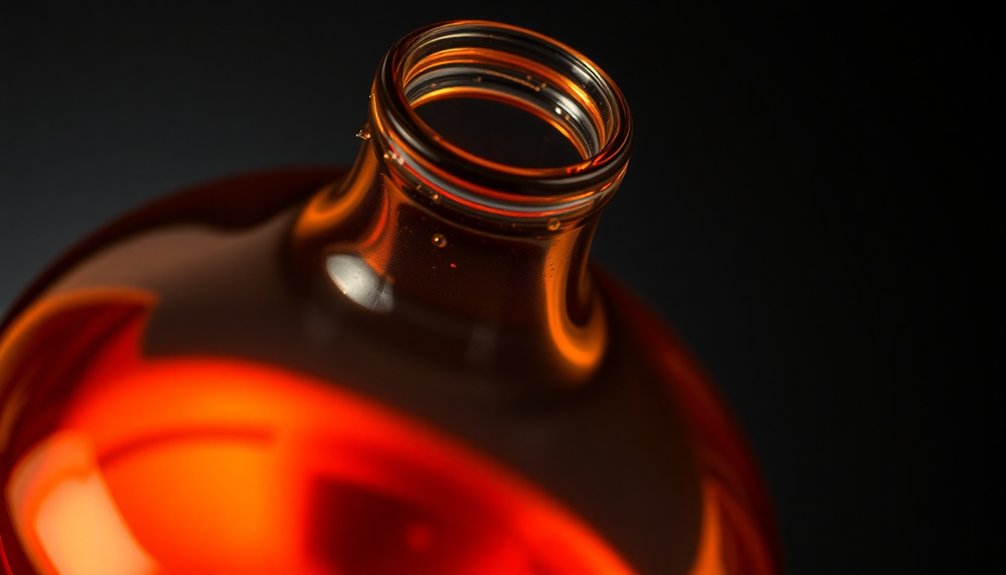Liquor bottles mainly use PET (Polyethylene Terephthalate) plastic because it's lightweight and durable. This material effectively protects the alcohol from outside elements, making it suitable for short-term storage. You'll often find PET in smaller bottle sizes, like 50 ml and 375 ml. For closures, polypropylene is typically used, enhancing safety with tamper-evident seals. While PET is practical, there are strong environmental concerns about plastic waste in the spirits industry. As you explore further, you'll discover more about sustainability initiatives and alternative packaging options that are gaining traction.
Key Takeaways
- Liquor bottles are primarily made from PET (Polyethylene Terephthalate), known for its lightweight and durable properties.
- PET is suitable for storing alcoholic beverages due to its ability to withstand corrosive liquids.
- PP (Polypropylene) is commonly used for closures and tamper-evident seals on liquor bottles.
- The spirits industry is actively working to reduce plastic waste, with initiatives like Bacardi's elimination of plastic pourers.
- Consumer preferences lean towards glass for its premium feel, despite the growing use of reinforced plastic containers.
Types of Plastics Used
When it comes to liquor bottles, you'll often find that PET (Polyethylene Terephthalate) is the go-to choice. This plastic provides a lightweight yet durable option for packaging various spirits. Its unique properties allow it to withstand the corrosive nature of alcoholic beverages, making it ideal for short-term storage.
You'll see PET used frequently in smaller bottle formats, like 50 ml and 375 ml, where it ensures adequate protection for the contents.
While PET dominates the market, other plastics also play a role in liquor bottle design. For instance, PP (Polypropylene) is often used for closures and tamper-evident seals. These materials complement the PET bottles by enhancing safety and convenience during use.
Bacardi's recent initiative to eliminate plastic pourers highlights a growing awareness about reducing plastic waste in liquor packaging. This effort shows that while PET is essential for the structure of liquor bottles, the industry is also exploring ways to minimize overall plastic usage.
The shift towards sustainable packaging is driven by concerns over microplastics and their potential impact on human health and the environment, prompting companies to rethink their use of plastics in liquor bottles.
Purpose of Plastic Inserts
Many people appreciate the convenience of plastic inserts, commonly known as pourers, which are designed to regulate the flow of liquid from larger liquor bottles.
These inserts enhance your pouring experience by preventing glugging and reducing spills. When you use a pourer, the design divides the bottle opening into quadrants, allowing air to enter as the liquor flows out. This balance of pressure slows the pouring rate, preventing splashing and waste.
While these plastic PET Long Neck pourers don't provide the same precision as a bartender's technique, they aim for consistency in pour speed, making them ideal for social gatherings or service settings.
Since they're typically used in larger bottles, they cater to higher-volume usage, giving you greater control over each pour.
Using a pourer means you can serve drinks more smoothly, whether you're mixing cocktails at a party or serving guests at a restaurant.
It is also important to consider the safety of the plastic used in these inserts, as some may contain BPA free alternatives that can still leach harmful chemicals, making it crucial to choose a safe and reliable option.
Environmental Impact of Plastic
Plastic pollution poses a significant threat to our environment, and the spirits industry is taking steps to address this issue. Bacardi's initiative to eliminate plastic pourers from their bottles aims to cut down about 140 tons of plastic waste each year. This move not only reduces environmental impact but also shows that sustainability can align with product quality. The overall recycling rate of plastics is still relatively low, with only about 9 percent of plastics being recycled, highlighting the need for increased efforts to improve recycling practices and reduce plastic waste.
The following table summarizes key initiatives in the spirits industry aimed at combating plastic waste:
| Initiative | Impact | Target Year |
|---|---|---|
| Elimination of Plastic Pourers | Reduces 140 tons of plastic | Annually |
| 100% Plastic-Free Packaging | Aligns with sustainability goals | By 2030 |
| NRF Removal | Maintains product quality | Ongoing |
Consumer Experiences With Plastic
The shift towards sustainability in the spirits industry has prompted a closer look at consumer experiences with plastic packaging. Many of you might appreciate the convenience of using PET Long Neck Liquor bottles for short-term storage, especially during lively events like festivals.
These bottles generally don't compromise the quality of the liquor, making them a popular choice for portable enjoyment.
However, there are concerns about long-term storage. Some of you might worry about potential contamination when keeping spirits in plastic bottles for extended periods, although many festival-goers report safe use without adverse effects.
It's also common to perceive plastic as inferior to glass, especially in terms of quality and presentation.
Your personal experiences may vary; for instance, some have faced glugging issues with plastic pourers, which can be frustrating despite their design.
Community feedback shows a growing trend toward reinforced plastic containers for spirits, as they strike a balance between durability and practicality for transport, all while helping reduce waste.
In the end, while the advantages of plastic are clear, it's essential to weigh your options based on your specific needs and preferences.
The use of plastic in liquor bottles also raises concerns about microplastic particles and their potential impact on the environment and human health, highlighting the need for eco-friendly alternatives.
Alternatives to Plastic Bottles
Choosing the right packaging for your favorite spirits can significantly impact your experience and the environment.
Fortunately, there are several alternatives to plastic bottles that you can consider:
- Glass Bottles: These offer a premium feel and are fully recyclable, with no risk of chemical leaching over time.
- Aluminum Cans: Lightweight and resistant to breakage, aluminum cans are perfect for on-the-go events, making them a convenient, eco-friendly option.
- Tetra Pak Packaging: Made from renewable materials, Tetra Pak is increasingly used for pre-mixed spirits, helping to reduce plastic waste.
- Reusable Containers: Stainless steel flasks are fantastic for portable spirit storage, encouraging you to ditch single-use plastic and promote sustainability.
When selecting alternatives to plastic, it's essential to prioritize BPA-free materials and opt for eco-friendly solutions to minimize environmental harm and ensure a safer drinking experience.
Frequently Asked Questions
What Kind of Plastic Are Liquor Bottles Made Of?
When you look at liquor bottles, you'll find they're often made from polyethylene terephthalate (PET). It's lightweight, durable, and recyclable, aligning with sustainable practices many brands are adopting to reduce their environmental impact.
Why Do Mexican Liquor Bottles Have That Plastic Thing?
Mexican liquor bottles have that plastic pourer to prevent spills and regulate flow. It helps you control pouring speed, avoiding glugging, and ensures the liquor's integrity by deterring illegal refilling. It's all about smoother serving!
Is Alcohol Plastic Safe?
Yes, alcohol in plastic containers is generally safe for short-term use. However, it's best to avoid long-term storage due to potential contamination risks. Always choose glass for quality and longer-lasting preservation of your spirits.
Why Did Bacardi Stop Putting Stoppers in Their Bottles?
You'll find Bacardi removed stoppers to cut down on plastic waste. This move supports their sustainability efforts, aiming to eliminate around 140 tons of plastic annually while ensuring product quality remains intact.

